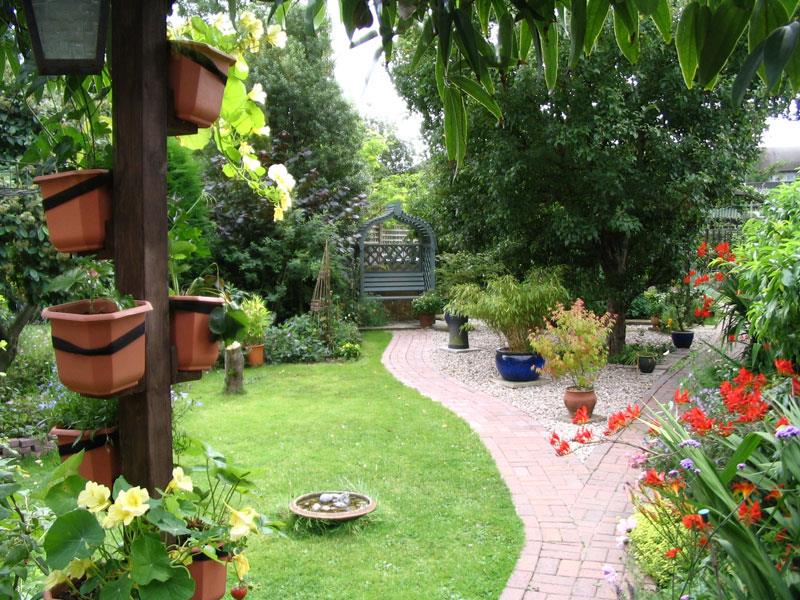
Copyright © 2014 by Nigel Lane All Rights reserved.
Seneca
It is not because things are difficult that we do not dare, it is because we do not dare that they are difficult.
It is not because things are difficult that we do not dare, it is because we do not dare that they are difficult.
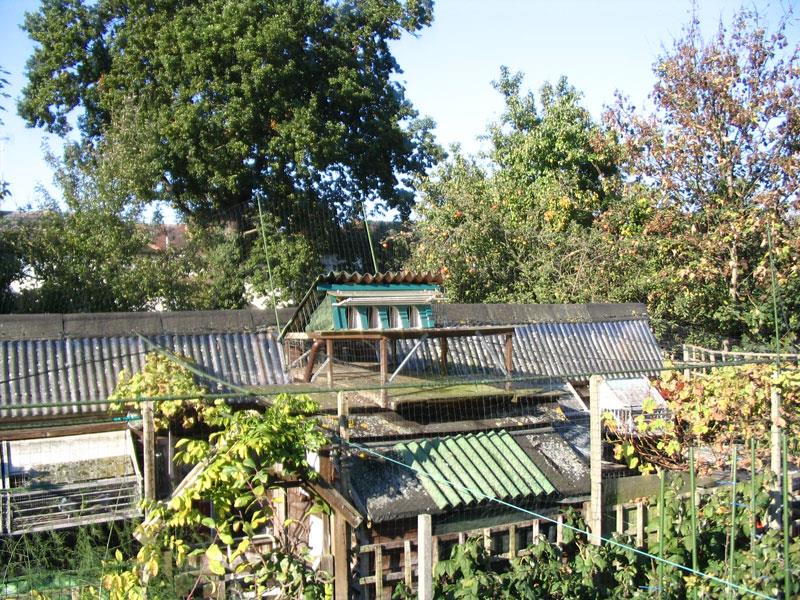
Almost a birds eye view.
To the left you can see the first of two sputniks, on the front of the hens section, through which everything leaves the loft. Beyond that, to the left and not shown in this photo, is a small section that could be used for natural and beyond that again a section for young birds.
In this photo you can see the one trap through which everything enters the loft sitting above a cage, used for young bird familiarization. To the right, as you look, are three cocks sections while in the centre is a store room for feed etc.


The Lofts.
The whole area is netted off at the cage height and down the front and sides to keep out cats etc.
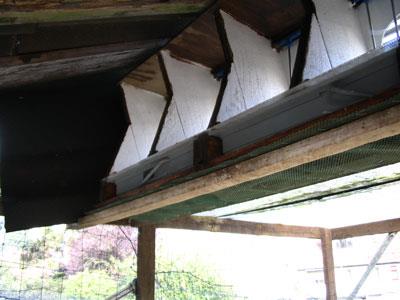
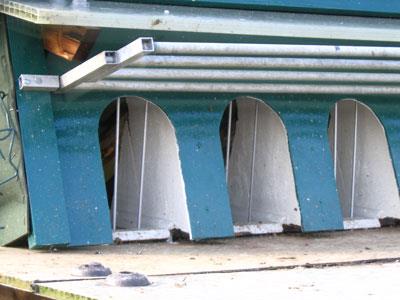
The pigeons enter the trap through the bob wires and pass over the ETS pads, which you can see from the inside. They then drop down into the cage and pass on down into a distribution box, from where they have two options.


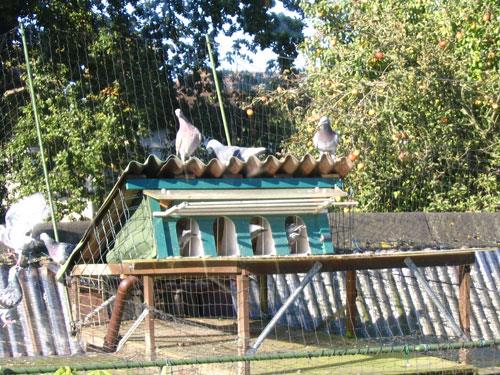
Some go in while others just play around.
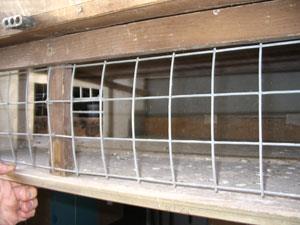
From the distribution box, (shown to the left) they can either go left to the hens section or the young bird section beyond or to the right (as they do in the video below) and the cocks sections, depending upon which access flap is open. Both flaps can be shut, and usually are unless arrivals are expected, acting as a holding area.
Someone commented, having seen the video, that the trapping system looked complicated followed by the question “Is it easy to train them to use it?” Well it is perhaps simpler than it appears as well as being practical and cost effective. Two things started it off, a persistent cat problem involving many losses, and ETS.
I have had ETS for many years now one of the first in the UK, which gives an idea of the vintage and prior to that there were Sputniks on all sections, still in place to this day. Netting over the lofts, to keep out the cats, and using one trap for the whole loft came together quite well and the cage helped to get the young birds up there for some pre-flight experience. ETS pads to fit all Sputniks, at today’s prices, would cost in excess of £1,400. Instead there are just two pads, but one would do, a large saving. That is just the cost of pads of course because you need traps with the pads and on it goes. Frankly this is not simply cheaper but easier and I believe better. Why better? One trap gives focus; it is one place to look at and one place to be. As we get older moving about gets more difficult but why should we move when we can get them, the birds to do it, they are the athletes after all. Before I could use the ETS in races, I always used it for my records of course, I had a stall trap and so whether you use ETS or conventional timing one trap is easier.
The pigeons have no trouble with it at all. They soon know where to go and very early in their lives the young birds are racing along the corridor. I wean them when they are feathered under the wing and leave them for three days to start picking up food and water. Then they start with three days being put into the corridor so that they have to drop down into their section to feed. Then they are put in the distribution box or collection area for three days when they learn to run the full length of the corridor to get to their section. Then they go in the cage for three days, perhaps more depending on how quickly they learn, but generally only three days and here they have to learn to drop down into the collection/distribution box and so to the corridor. Once they have done this successfully a couple of times they go out in a basket and I gently toss them up onto the platform. Most go through the trap just like that though some are a little more circumspect. Sometime of course they take off and fly and then it can be a matter of luck whether they return but losses from this have been very low. Again I toss them like this for a couple of days and then they have to learn fly out through the door.
I have had ETS for many years now one of the first in the UK, which gives an idea of the vintage and prior to that there were Sputniks on all sections, still in place to this day. Netting over the lofts, to keep out the cats, and using one trap for the whole loft came together quite well and the cage helped to get the young birds up there for some pre-flight experience. ETS pads to fit all Sputniks, at today’s prices, would cost in excess of £1,400. Instead there are just two pads, but one would do, a large saving. That is just the cost of pads of course because you need traps with the pads and on it goes. Frankly this is not simply cheaper but easier and I believe better. Why better? One trap gives focus; it is one place to look at and one place to be. As we get older moving about gets more difficult but why should we move when we can get them, the birds to do it, they are the athletes after all. Before I could use the ETS in races, I always used it for my records of course, I had a stall trap and so whether you use ETS or conventional timing one trap is easier.
The pigeons have no trouble with it at all. They soon know where to go and very early in their lives the young birds are racing along the corridor. I wean them when they are feathered under the wing and leave them for three days to start picking up food and water. Then they start with three days being put into the corridor so that they have to drop down into their section to feed. Then they are put in the distribution box or collection area for three days when they learn to run the full length of the corridor to get to their section. Then they go in the cage for three days, perhaps more depending on how quickly they learn, but generally only three days and here they have to learn to drop down into the collection/distribution box and so to the corridor. Once they have done this successfully a couple of times they go out in a basket and I gently toss them up onto the platform. Most go through the trap just like that though some are a little more circumspect. Sometime of course they take off and fly and then it can be a matter of luck whether they return but losses from this have been very low. Again I toss them like this for a couple of days and then they have to learn fly out through the door.
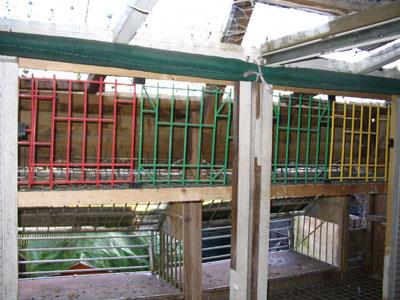
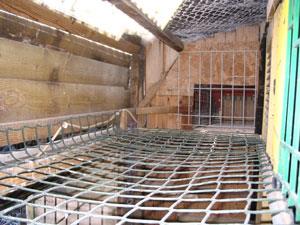
The photo to the right shows the hens section and at the top is the tunnel way that leads across the hens section to the young birds area while beneath that is access to sputniks through which all birds leave the loft.
In the photo to the left we see the inside of the tunnel way leading through the gate at the end to the young bird area
While in the that below, we can see back along the tunnel way to the distribution box where all birds entering the loft arrive.
While in the that below, we can see back along the tunnel way to the distribution box where all birds entering the loft arrive.
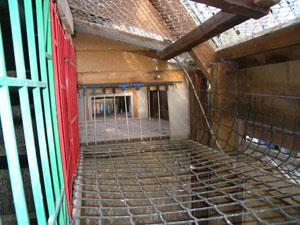
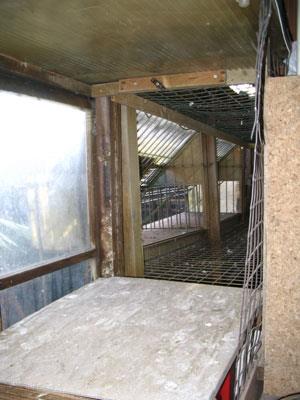
Here, to the left, the route the cocks take to move out of their sections and into the sputniks, from where the exit the loft.
While the picture below shows the gateway open for the hens to get back into their section from the tunnel way and also preventing them from going further down the tunnel way.
While the picture below shows the gateway open for the hens to get back into their section from the tunnel way and also preventing them from going further down the tunnel way.
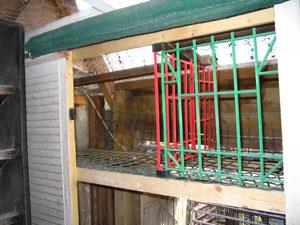
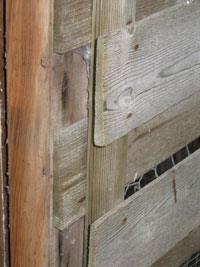
The loft front is constructed from 4" timber planks with a 3" gap between each. A second layer of planks is attached in a similar manner to a 1" batten and aligned so that the outer planks cover the gaps on the inner layer. In this way there is a free flow of air through the wall but the worst of weather is kept out of the loft. There is wire mesh on the inside to dissuade any unwanted quests.
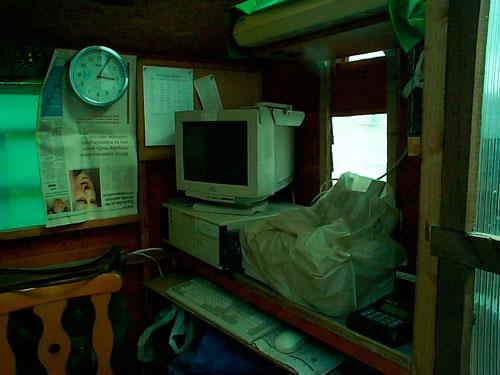

Beneath the cage is the loft office equipped with telephone, old computer, ETS and printer.
Here the ETS loft clock showing the arrival of 57762, dam of the Team's No1 and 3, from a training toss back in 2004.
From the back door of the house the lofts are difficult to spot, which is exactly the way another member of the household wants things to be.
From the back door of the house the lofts are difficult to spot, which is exactly the way another member of the household wants things to be.
